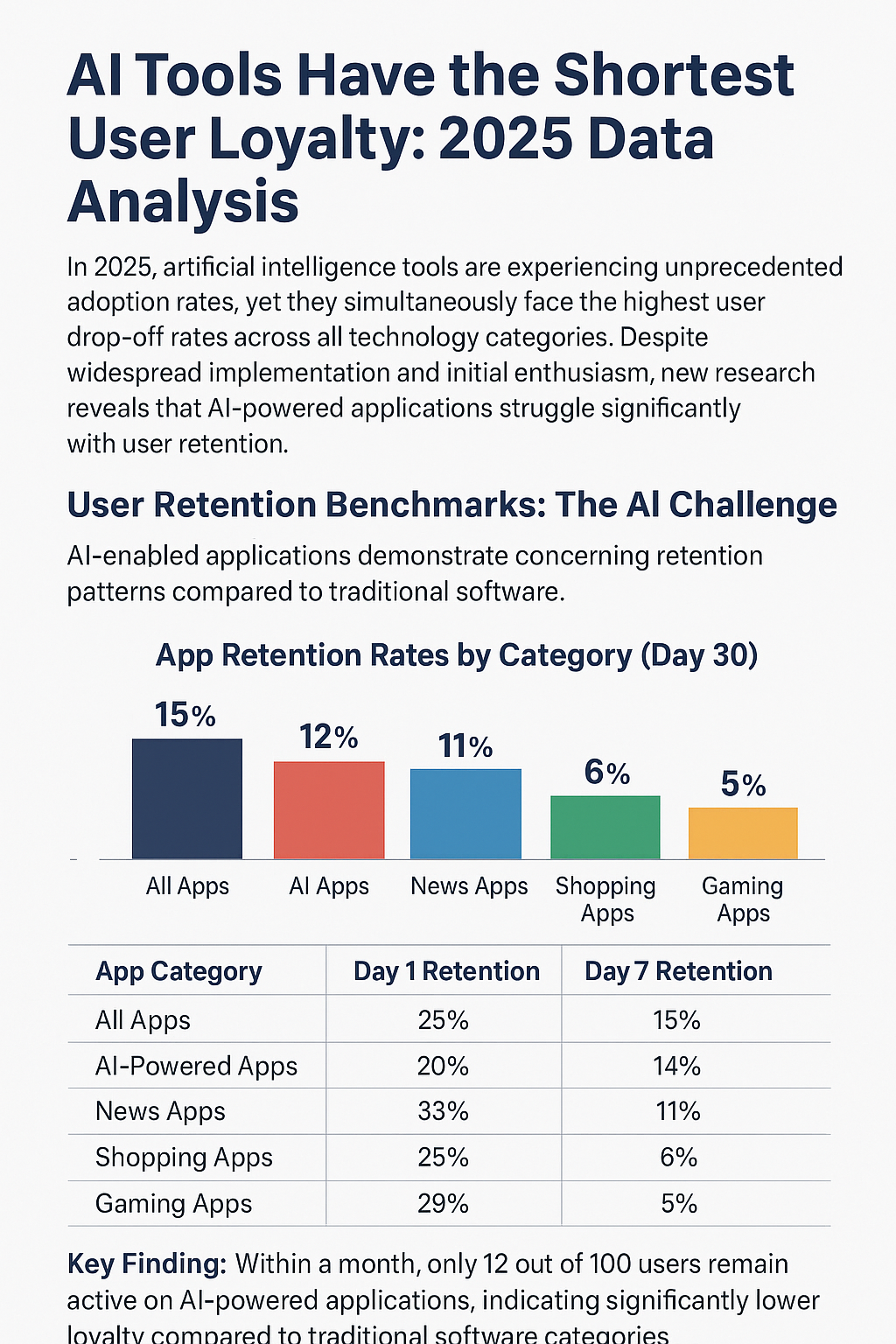In 2025, artificial intelligence tools are experiencing unprecedented adoption rates, yet they simultaneously face the highest user drop-off rates across all technology categories. Despite widespread implementation and initial enthusiasm, new research reveals that AI-powered applications struggle significantly with user retention, presenting a critical challenge for the technology sector.
User Retention Benchmarks: The AI Challenge
According to comprehensive industry analysis, AI-enabled applications demonstrate concerning retention patterns compared to traditional software. While AI usage statistics show rapid adoption, the sustainability of that usage tells a different story.
App Retention Rates by Category (Day 30)
| App Category | Day 1 Retention | Day 7 Retention | Day 30 Retention |
|---|---|---|---|
| All Apps | 25% | 18% | 15% |
| AI-Powered Apps | 20% | 14% | 12% |
| News Apps | 33% | 16% | 11% |
| Shopping Apps | 25% | 11% | 6% |
| Gaming Apps | 29% | 10% | 5% |
AI User Trust and Data Privacy Concerns
Research from leading institutions reveals that consumer trust remains a fundamental barrier to sustained AI adoption. The relationship between AI chatbots trusted with sensitive data and user retention demonstrates clear correlation patterns.
Consumer AI Trust Levels (2025)
Distrust AI (54%)
Trust AI (46%)
Data Privacy Concerns (70%)
Regulation Needed (70%)
A comprehensive University of Melbourne study spanning 47 countries found that while 66% of people use AI regularly, only 46% express willingness to trust AI systems. This trust deficit directly correlates with user abandonment patterns observed across AI applications.
AI in Customer Service and Chatbot Adoption
Despite challenges with trust, AI tools used at work continue expanding, particularly in customer service applications. The adoption of AI chatbots presents both opportunities and retention challenges.
AI Chatbot Usage and Preference Statistics
Consumer behavior analysis reveals that 68% of consumers have used automated customer service chatbots, with 62% preferring chatbot interactions over waiting for human agents. However, this preference for speed doesn’t translate to long-term loyalty, as evidenced by the 28% return rate associated with AI-driven customer service interactions.
AI Implementation in Loyalty Programs
The integration of artificial intelligence in loyalty programs represents a significant investment area, yet demonstrates mixed results in terms of user retention and program effectiveness. Current industry analysis shows that while Chrome permissions and user control preferences influence AI acceptance, loyalty program performance varies significantly.
AI Loyalty Program Performance Metrics
According to comprehensive industry research, 37% of loyalty programs now incorporate AI technology, yet only 22% report significant improvements in repeat customer engagement. This disconnect between investment and results highlights the challenges faced in converting AI capabilities into sustained user loyalty.
| Loyalty Program Metric | Traditional Programs | AI-Enhanced Programs | Performance Gap |
|---|---|---|---|
| Average ROI | 4.8x | 5.2x | +8.3% |
| Significant Engagement Boost | 30-40% | 22% | -20% |
| Programs Using Technology | 63% | 37% | -41% |
| User Satisfaction Rate | 70% | 68% | -2.9% |
The Chrome and Browser Ecosystem Impact
The browser environment significantly influences AI tool adoption and retention patterns. Research into global Chrome user base behavior reveals important insights about how users interact with AI-powered web applications and extensions.
Analysis of Chrome extension ecosystem data shows that AI-powered extensions face unique retention challenges. Users frequently install AI tools but abandon them within weeks, contributing to the broader pattern of short-lived AI engagement observed across platforms.
Student and Educational AI Usage Patterns
Educational environments provide particularly revealing insights into AI tool loyalty patterns. Research examining AI chatbot usage by students demonstrates that even in academic settings where AI tools provide clear utility, sustained engagement remains challenging.
The pattern observed in educational contexts mirrors broader market trends, where initial adoption enthusiasm fails to translate into long-term user loyalty. This is particularly significant given that educational users typically have clearly defined use cases and measurable benefits from AI tool usage.
Leading AI Platforms and Retention Challenges
Major AI platforms face similar retention challenges despite their market-leading positions. Analysis of ChatGPT statistics, Claude usage trends, and Google Gemini statistics reveals consistent patterns across leading platforms.
Even well-established platforms like those tracked in Perplexity user trends demonstrate the industry-wide challenge of converting initial user interest into sustained engagement and loyalty.
The Future of Work and AI Replacement Concerns
User retention challenges are compounded by concerns about AI’s impact on employment and professional roles. Questions around AI replacement of human workers create additional friction in user adoption and long-term engagement with AI tools.
This psychological barrier contributes to the abandonment patterns observed across AI applications, as users grapple with both practical utility and broader implications of AI integration in their professional and personal lives.
Comparative Analysis: AI Tools vs Traditional Software
Retention Comparison: AI vs Traditional Applications
| Metric | AI Tools | Traditional Apps | Performance Gap |
|---|---|---|---|
| Day 30 Retention (Mobile) | 12% | 15% | -20% |
| User Abandonment Due to AI Issues | 39% | 15% | +160% |
| Trust in Purchase Decisions | 34% | N/A | – |
| Executive Value Assessment | 27% | N/A | – |
| Projects Showing Significant ROI | 22% | 30-40% | -35% |
Root Causes of Short AI Tool Loyalty
The data reveals several fundamental challenges contributing to poor AI tool retention:
Industry Implications and Future Outlook
The research indicates that despite executive enthusiasm and technical advancement, AI tools face fundamental challenges in building sustainable user relationships. The pattern suggests that successful AI implementations must prioritize:
- Transparent operation and data handling practices
- Realistic capability communication to manage user expectations
- Proactive user empowerment rather than reactive service patches
- Measurable utility that justifies continued engagement
Conclusion
The data reveals a critical paradox in the AI industry: while adoption rates continue climbing, user loyalty remains persistently low across all categories of AI tools. The combination of high initial interest, unmet expectations, privacy concerns, and implementation shortcomings creates a perfect storm for user abandonment.
Organizations investing in AI technology must recognize that technical capability alone is insufficient for building sustainable user relationships. Success in the AI space will require fundamental shifts toward transparency, user empowerment, and genuine utility that justifies long-term engagement.
As 2025 progresses, only AI tools that successfully address these core challenges will break free from the pattern of rapid adoption followed by equally rapid abandonment that currently characterizes the industry.
Frequently Asked Questions
Why do AI tools have lower retention rates than traditional apps?
+
AI tools face unique challenges including unmet user expectations, privacy concerns, and transparency issues. Research shows that only 13% of users feel AI interactions are truly personalized, while 39% abandon AI tools due to errors and 50% due to data privacy concerns. These factors combine to create higher abandonment rates compared to traditional applications.
What percentage of users trust AI with their data?
+
According to recent studies, only 46% of people globally are willing to trust AI systems, while 70% believe AI regulation is needed. In specific regions, 87% of UK consumers, 92% of US consumers, and 93% of Australian consumers are concerned that AI will make data security more challenging.
How effective are AI-powered loyalty programs?
+
While 37% of loyalty programs now include AI technology, only 22% report significant improvements in repeat customer engagement. AI-driven programs can increase average order value by 22-40%, but they struggle to create the sustained engagement patterns necessary for long-term user retention.
What is the average retention rate for AI applications after 30 days?
+
AI-powered applications have a Day 30 retention rate of approximately 12%, compared to 15% for all apps generally. This means that within a month, only 12 out of 100 users remain active on AI applications, indicating significantly lower loyalty compared to traditional software categories.
Do consumers prefer AI chatbots or human customer service?
+
Consumer preferences are mixed: 62% prefer chatbots over waiting for human agents when speed is prioritized, and 68% have used automated customer service chatbots. However, this preference for speed doesn’t translate to long-term loyalty, as evidenced by high return rates and abandonment patterns in AI customer service implementations.
What are the main reasons users abandon AI tools?
+
The primary reasons include: expectation mismatches (only 13% feel AI is truly personalized), data privacy concerns (affecting 50% of users), AI errors and mistakes (causing 39% to abandon), lack of transparency in AI operations, and inadequate user control over AI decision-making processes.
Sources
- University of Melbourne & KPMG. (2025). Trust, attitudes and use of Artificial Intelligence: A global study 2025
- Business of Apps. (2025). App Retention Rates 2025
- Antavo. (2025). Global Customer Loyalty Report 2025
- Cohesity. (2024). Consumer AI Data Concerns Survey
- Zendesk. (2025). AI Customer Service Statistics for 2025

